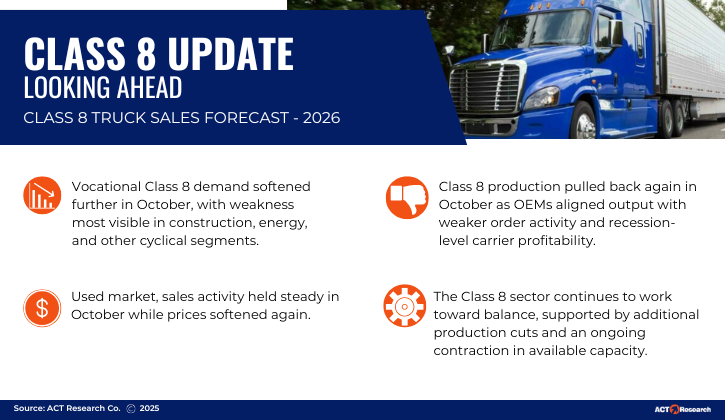
2026 Class 8 Truck Market
November 2025
Updated November 21, 2025
Infrastructure and Construction Support
Vocational Class 8 demand softened further in October, with weakness most visible in construction, energy, and other cyclical segments. Infrastructure- and utility-related activity continues to provide a stable—but modest—base of demand, though public project delays and elevated input costs continue to cap overall momentum.
OEMs report that vocational inventories remain elevated and are normalizing more slowly than tractor stock. Vocational units now represent a significantly larger share of Class 8 inventory than normal. Manufacturers have continued to trim daily build rates heading into Q4 to work down excess stock. Despite the ongoing support from infrastructure programs, the broader vocational environment remains subdued.
Production and Backlogs
Class 8 production pulled back again in October as OEMs aligned output with weaker order activity and recession-level carrier profitability. October orders underperformed seasonal norms, posting one of the softest autumn readings in several years.
Backlogs increased from September, driven by reduced builds rather than stronger demand. The backlog-to-build (BL/BU) ratio remained near recent highs, reflecting extended lead times despite subdued bookings. Retail sales slipped below replacement levels for the first time since early 2024, and inventories continued to edge lower as OEMs emphasize discipline and margin protection.
Regulatory Shifts
EPA 2027 remains the largest outstanding regulatory variable. With less than 14 months until the scheduled implementation date—and no updated guidance—uncertainty is intensifying. Industry expectations now center on a partial rollback, with the technology provisions likely to remain but warranty and useful-life extensions potentially pushed out. This uncertainty continues to suppress prebuy behavior, limiting orders to essential replacements.
At the same time, 232 tariffs on heavy vehicles and major components are now fully priced into the market. These tariffs have materially increased equipment costs, adding several thousand dollars per truck before taxes, financing, or insurance. Combined with elevated borrowing and operating costs, the tariff burden continues to weigh heavily on capital planning heading into 2026.
Capacity Rebalancing
The Class 8 sector continues to work toward balance, supported by additional production cuts and an ongoing contraction in available capacity. Tractor inventories are trending toward normal levels as OEMs reduce output, but vocational inventories remain high and account for a disproportionate share of the Class 8 stock.
In the used market, sales activity held steady in October while prices softened again. Values have now declined for several months in a row, with younger and late-model units showing some resilience but older equipment facing significant price pressure. Retirements have increased slightly as fleets work through aging equipment, but overall capacity still exceeds current freight demand, keeping new sales anchored to replacement.
Moderate Growth in Orders
Class 8 order activity remained muted in October. Total orders lagged seasonal norms and were down relative to last year, reflecting cautious fleet sentiment and weaker freight fundamentals. Tractor orders improved slightly from September but remained well below typical October levels, while vocational bookings continued to trail amid elevated input costs and slow-moving construction activity.
Cancellations were low, indicating that existing commitments are holding, even as fleets remain hesitant to add incremental capacity. OEMs continue to manage production deliberately, prioritizing profitability and orderboard stability as they open additional 2026 slots.

Economic Tailwinds and Risks
Infrastructure spending continues to act as a limited tailwind, but broader economic pressures dominate the outlook. Tariff-driven inflation, uncertain trade policies, and high financing costs are contributing to one of the most challenging operating environments for carriers in more than a decade. Freight-intensive sectors—housing, manufacturing, and energy—remain soft, while consumer-related shipments have begun to reflect the early stages of post-tariff paybacks.
Smaller carriers remain particularly vulnerable, facing tight credit, ongoing cost inflation, and limited pricing power. As fleets move into late 2025 and early 2026, priorities remain centered on cost containment, equipment life extension, and liquidity management. A more meaningful recovery in Class 8 demand will depend on freight stabilization and greater regulatory clarity entering 2026.

Want more data?
ACT’s commercial vehicle forecast delivers the most reliable, forward-looking insight into where Class 8 truck sales are headed—helping you anticipate shifts, plan with confidence, and stay ahead of the market.